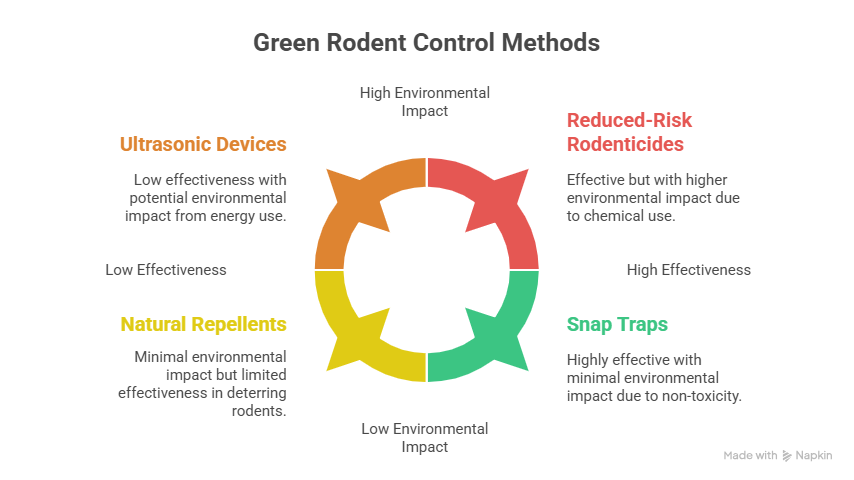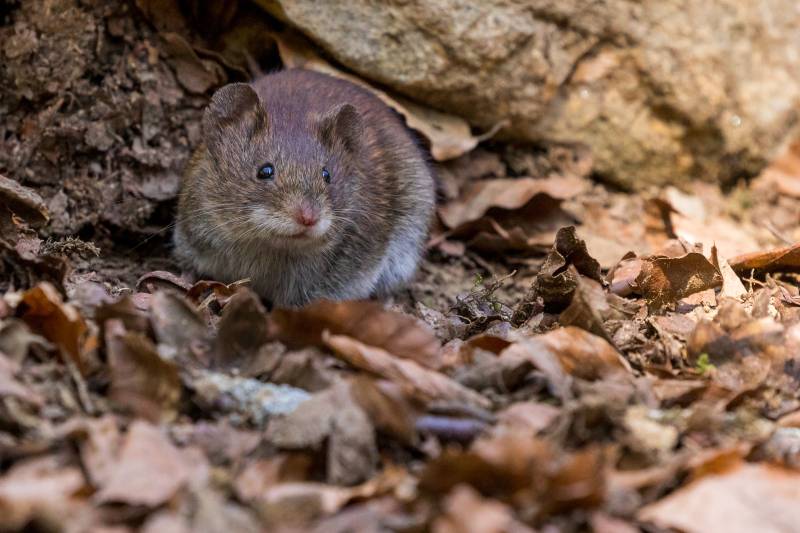Welcome to the Urban Wild: Chicago’s Rodent Problem Meets a Greener Solution
There’s no sugarcoating it, Chicago has a rat problem. Year after year, the Windy City finds itself on top of the nation’s “rattiest city” lists, and for good reason. With dense urban neighborhoods, aging infrastructure, alleys packed with refuse, and fluctuating seasonal temperatures, Chicago is practically a playground for rats and mice. But here’s the twist: the battle against these unwelcome guests doesn’t have to be toxic.
Enter green pest control.
More and more homeowners, renters, and property managers in Chicago are demanding eco-friendly approaches to rodent removal that don’t just nuke the nest with poison. Instead, they’re looking for long-term, sustainable solutions that protect kids, pets, and the planet. The good news? Local companies like Midwest Pest Solutions are leading that green revolution, showing that effective rodent control doesn’t have to come at the cost of environmental or personal safety.
Why Green Pest Control? It’s More Than Just a Trend
Let’s get something straight, green pest control isn’t just about ditching the chemicals. It’s a philosophy. A strategy. And yes, sometimes it’s even a lifestyle choice.
Green pest management, especially when applied to rodent control, focuses on:
- Prevention over reaction
- Exclusion over extermination
- Targeted treatments over blanket poisons
- Monitoring over guessing
For families and businesses in Chicago, that translates into fewer risky toxins around food areas, safer indoor air, and less risk of harming beneficial urban wildlife (like hawks and owls that actually eat rodents for free).
Companies like Midwest Pest Solutions are at the forefront of this approach. Their eco-conscious services focus on long-term rodent control through sealing entry points, using humane traps, and applying green repellents, all tailored specifically to Chicago’s rodent species and climate.
Meet the Enemy: Chicago’s Most Common Rodents
Before we get into the methods, let’s quickly identify who we’re up against:
Norway Rats
These brutes are the ones you might spot in alleys or chewing through garbage cans. They’re large, aggressive, and can chew through concrete. (Yes, you read that right, concrete.)
House Mice
Don’t let the name fool you, these nimble invaders love apartments, basements, attics, and pantries. One pregnant female mouse can give birth to up to 60 pups per year. Multiply that over a couple of months and, well… you get the picture.
Roof Rats
A bit rarer in Chicago but still present, especially in tree-lined neighborhoods. They’re climbers and often invade from above via rooflines or vents.
Each species requires slightly different handling, which is why green pest control professionals rely on identification and surveillance before jumping to treatment.
Integrated Pest Management (IPM): The Green Backbone
Ask any serious eco-friendly exterminator in Chicago about their method, and they’ll almost certainly say “IPM.” Short for Integrated Pest Management, IPM is the backbone of green rodent control strategies, and it’s as much about brains as it is about brawn.
Here’s how IPM plays out in rodent control:
1. Inspection
Before anything gets set or sprayed, a thorough inspection is conducted. This means crawling into crawlspaces, checking baseboards, peeking into utility closets, anywhere a rodent might be nesting or passing through. Professionals will look for droppings, gnaw marks, urine trails (yes, black lights are a thing), and even listen for scratching inside the walls.
2. Identification
Not all rodents are created equal. A good pest control expert will identify not just what kind of rodent is present, but where they’re coming from, what they’re eating, and why they’ve chosen your home as their vacation spot.
3. Exclusion
Think of this as rodent-proofing your space. Steel wool, copper mesh, hardware cloth, and sealant are used to block access points, vents, foundation cracks, pipe openings. It’s detailed work and honestly one of the most underrated parts of green pest control. Exclusion is prevention. Period.
4. Eco-Friendly Control Tools
Here’s where the green methods truly shine. Rather than just tossing poison around, the pros might use:
- Snap traps and electronic traps: Quick and humane.
- Live catch traps: Ideal for release if local regulations permit.
- Natural deterrents: Essential oils like peppermint, eucalyptus, and citronella can disrupt rodent scent trails and discourage them from nesting.
Going Green Doesn’t Mean Going Soft
Some people still think green pest control is code for “it’s probably not going to work.” That couldn’t be more wrong.
Chicago pest control companies, especially firms like Midwest Pest Solutions, combine scientific knowledge with cutting-edge, eco-conscious tools. Their approach doesn’t just solve the problem, it addresses the conditions that allowed it to start in the first place. And that’s the whole point of green pest control.
So whether you’re in Logan Square or Rogers Park, if you’ve heard scratching in the walls or found mysterious gnaw marks under your kitchen sink, there’s a smart, sustainable way to handle it.


Tools of the Trade: Green Rodent Control That Works in the Real World
So you’ve sealed the holes, eliminated food sources, and identified your rodent foes. Now what? This is where green rodent control moves from prevention to action, strategically, safely, and with minimal environmental footprint.
Let’s break down the most effective green rodent control tools used by professionals throughout Chicago, many of which are endorsed by nationally recognized environmental and pest control authorities.
Snap Traps: Old School, Still Cool (and Green)
Yes, the classic wooden snap trap is still one of the greenest tools in the rodent control arsenal. It’s non-toxic, highly effective, and inexpensive. When placed strategically, along walls, behind appliances, near baseboards, snap traps can deliver quick results without spreading poison throughout your home or building.
The trick lies in placement and baiting. Pest control pros trained in green methods will pre-bait traps (offering food without setting them) to build trust with cautious rodents before striking. Think of it as reverse psychology, rat edition.
Live Catch Traps: For the Compassionate Exterminator
For those who just can’t stomach lethal traps, live catch-and-release traps offer a humane alternative. These cage-style traps allow for rodents to be caught without injury and then relocated, ideally at least a mile from the original site, in accordance with local guidelines.
But a word of caution here: Chicago’s Department of Streets and Sanitation doesn’t recommend releasing rodents back into the urban wild, due to public health concerns. In many cases, it’s more responsible to call a professional to handle the release, or opt for a quick, humane kill method.
Natural Repellents: Peppermint Isn’t Just for Tea
One of the biggest myths about green pest control is that it’s all about smells. Yes, essential oils like peppermint, citronella, and eucalyptus can help deter rodents, but they’re not a silver bullet.
Professionals may use these oils strategically, often in areas where exclusion isn’t possible (like inside wall voids or crawlspaces). Combined with other methods, essential oils help create an environment that’s hostile to nesting and reproduction.
For DIYers, the Environmental Protection Agency (EPA) recommends looking for green-certified pest deterrent products that meet Safer Choice standards. These products are tested for both effectiveness and environmental safety.
Ultrasonic Devices: Hype or Help?
You’ve probably seen these marketed online, plug-in ultrasonic devices that claim to drive rodents away with high-frequency sound waves. While they might sound promising, the science is inconclusive at best.
The National Pesticide Information Center (NPIC) notes that ultrasonic repellents may only have a short-term impact and rodents often adapt to the sound. Reputable green pest control companies typically use them only as a minor supplement, not a standalone solution.
Exclusion Materials: Small Details, Big Difference
Blocking access is one of the most overlooked but powerful green strategies out there. Materials like:
- Steel wool
- Copper mesh
- Hardware cloth
- Rodent-proof caulking
…are used to seal gaps as small as ¼ inch. Yes, mice can squeeze through holes that small. Some specialists even use infrared cameras or UV light to detect entry points invisible to the naked eye.
The Centers for Disease Control and Prevention (CDC) recommends exclusion and sanitation as the primary strategies for long-term rodent control, especially when dealing with health threats like hantavirus or salmonella, both of which rodents can carry.
Reduced-Risk Rodenticides: The Last Resort
Green pest control doesn’t mean zero chemical use, it means selective, minimized, and responsibly managed use. When infestations are severe or exclusion is impossible (think: massive apartment complexes or derelict buildings), licensed professionals may use EPA-approved, reduced-risk rodenticides.
But here’s the kicker: these chemicals are only deployed after all other options have been tried. Often, they’re placed in tamper-proof bait stations inaccessible to pets, kids, and non-target wildlife.
Midwest pest experts often follow Integrated Pest Management (IPM) protocols, which explicitly promote reduced pesticide use in favor of sustainable alternatives. That’s a win for everyone, especially the environment.
FAQs About Green Rodent Control in Chicago
Are green rodent control methods safe for pets and kids?
Yes! Most green techniques avoid toxic chemicals and use physical barriers, humane traps, and natural repellents instead, keeping your family safe.
Can green pest control handle major infestations?
Absolutely. With the right strategy, eco-friendly pest control can eliminate even severe rodent issues using humane and sustainable methods.
How do I prevent rodents from returning?
Exclusion is key. Sealing entry points, reducing food sources, and regular inspections keep rodents out for good.
Does the City of Chicago offer any green rodent control support?
Yes. The City’s Rodent Control Program provides free baiting and sanitation resources for some areas, though professional eco services offer deeper, ongoing support.
How often should I schedule green pest control services?
Most professionals recommend quarterly inspections and seasonal adjustments, especially in spring and fall when rodent activity spikes.
Local Laws and Green Rodent Control in Chicago
In a city like Chicago, rodent control is more than a household concern, it’s a civic issue.
Under the Chicago Municipal Code, property owners are responsible for keeping their premises free of rats. That means landlords, restaurants, and even tenants can face fines if they fail to deal with infestations. Thankfully, the city also provides some support.
The City of Chicago’s Rodent Control Program offers free inspections and baiting services for city property, alleys, and certain public-facing areas. They also promote sanitation campaigns and neighborhood engagement efforts that align closely with green pest control principles.
Eco-conscious companies like Midwest Pest Solutions often work alongside these city services, offering residents a more personalized, long-term solution beyond the basic municipal response. Their team combines urban compliance with eco-intelligence, tailoring every treatment to be safe, legal, and effective.
Tools of the Trade: Green Rodent Control That Works in the Real World
So you’ve sealed the holes, eliminated food sources, and identified your rodent foes. Now what? This is where green rodent control moves from prevention to action, strategically, safely, and with minimal environmental footprint.
Let’s break down the most effective green rodent control tools used by professionals throughout Chicago, many of which are endorsed by nationally recognized environmental and pest control authorities.
Snap Traps: Old School, Still Cool (and Green)
Yes, the classic wooden snap trap is still one of the greenest tools in the rodent control arsenal. It’s non-toxic, highly effective, and inexpensive. When placed strategically, along walls, behind appliances, near baseboards, snap traps can deliver quick results without spreading poison throughout your home or building.
The trick lies in placement and baiting. Pest control pros trained in green methods will pre-bait traps (offering food without setting them) to build trust with cautious rodents before striking. Think of it as reverse psychology, rat edition.
Live Catch Traps: For the Compassionate Exterminator
For those who just can’t stomach lethal traps, live catch-and-release traps offer a humane alternative. These cage-style traps allow for rodents to be caught without injury and then relocated, ideally at least a mile from the original site, in accordance with local guidelines.
But a word of caution here: Chicago’s Department of Streets and Sanitation doesn’t recommend releasing rodents back into the urban wild, due to public health concerns. In many cases, it’s more responsible to call a professional to handle the release, or opt for a quick, humane kill method.
Natural Repellents: Peppermint Isn’t Just for Tea
One of the biggest myths about green pest control is that it’s all about smells. Yes, essential oils like peppermint, citronella, and eucalyptus can help deter rodents, but they’re not a silver bullet.
Professionals may use these oils strategically, often in areas where exclusion isn’t possible (like inside wall voids or crawlspaces). Combined with other methods, essential oils help create an environment that’s hostile to nesting and reproduction.
For DIYers, the Environmental Protection Agency (EPA) recommends looking for green-certified pest deterrent products that meet Safer Choice standards. These products are tested for both effectiveness and environmental safety.
Ultrasonic Devices: Hype or Help?
You’ve probably seen these marketed online, plug-in ultrasonic devices that claim to drive rodents away with high-frequency sound waves. While they might sound promising, the science is inconclusive at best.
The National Pesticide Information Center (NPIC) notes that ultrasonic repellents may only have a short-term impact and rodents often adapt to the sound. Reputable green pest control companies typically use them only as a minor supplement, not a standalone solution.
Exclusion Materials: Small Details, Big Difference
Blocking access is one of the most overlooked but powerful green strategies out there. Materials like:
- Steel wool
- Copper mesh
- Hardware cloth
- Rodent-proof caulking
…are used to seal gaps as small as ¼ inch. Yes, mice can squeeze through holes that small. Some specialists even use infrared cameras or UV light to detect entry points invisible to the naked eye.
The Centers for Disease Control and Prevention (CDC) recommends exclusion and sanitation as the primary strategies for long-term rodent control, especially when dealing with health threats like hantavirus or salmonella, both of which rodents can carry.
Reduced-Risk Rodenticides: The Last Resort
Green pest control doesn’t mean zero chemical use, it means selective, minimized, and responsibly managed use. When infestations are severe or exclusion is impossible (think: massive apartment complexes or derelict buildings), licensed professionals may use EPA-approved, reduced-risk rodenticides.
But here’s the kicker: these chemicals are only deployed after all other options have been tried. Often, they’re placed in tamper-proof bait stations inaccessible to pets, kids, and non-target wildlife.
Midwest pest experts often follow Integrated Pest Management (IPM) protocols, which explicitly promote reduced pesticide use in favor of sustainable alternatives. That’s a win for everyone, especially the environment.
Local Laws and Green Rodent Control in Chicago
In a city like Chicago, rodent control is more than a household concern, it’s a civic issue.
Under the Chicago Municipal Code, property owners are responsible for keeping their premises free of rats. That means landlords, restaurants, and even tenants can face fines if they fail to deal with infestations. Thankfully, the city also provides some support.
The City of Chicago’s Rodent Control Program offers free inspections and baiting services for city property, alleys, and certain public-facing areas. They also promote sanitation campaigns and neighborhood engagement efforts that align closely with green pest control principles.
Eco-conscious companies like Midwest Pest Solutions often work alongside these city services, offering residents a more personalized, long-term solution beyond the basic municipal response. Their team combines urban compliance with eco-intelligence, tailoring every treatment to be safe, legal, and effective.
Real Impact: How Green Rodent Control Benefits Chicago Homes and Businesses
Eco-friendly rodent control isn’t just smart, it’s strategic. Whether you live in a vintage Greystone walk-up in Lakeview or manage a trendy café in Wicker Park, going green means:
- Protecting your reputation (no one wants a “rat problem” on Yelp)
- Keeping pets and children safe from harsh chemicals
- Complying with evolving Chicago regulations and tenant expectations
- Promoting long-term prevention rather than repeated extermination
Many Chicagoans have already seen success using services like Midwest Pest Solutions, from commercial kitchens to multi-family buildings. Their eco-conscious methods work because they don’t just treat the problem, they redesign the environment that allows rodents to thrive in the first place.
Common Green Rodent Control Myths… Busted
Let’s put a few misconceptions to bed, shall we?
❌ “Green pest control isn’t strong enough.”
Wrong. When done right, green methods like exclusion and IPM can outlast chemical solutions that rodents adapt to or avoid.
❌ “You have to choose between safety and effectiveness.”
Nope. Green pest control balances both. The key is targeted strategy over blunt force.
❌ “It’s more expensive.”
Not really. Upfront, green services might seem pricier, but fewer repeat visits and less damage repair usually mean lower costs over time.
❌ “Rodents will just come back anyway.”
If you’ve got the right team sealing, trapping, monitoring, and maintaining the environment, they won’t. And if they do, reputable providers like Midwest Pest Solutions offer ongoing monitoring to keep them gone.
Final Thoughts: Why Midwest Pest Solutions Is Chicago’s Green Rodent Control Ally
Rodent infestations in Chicago are a real problem, but toxic chemicals don’t have to be the default answer. Companies like Midwest Pest Solutions offer an eco-savvy alternative that’s just as tough on pests as it is gentle on the environment.
With proven methods like Integrated Pest Management, natural deterrents, humane trapping, and meticulous exclusion techniques, Midwest Pest Solutions gives Chicago residents something rare: pest control with a conscience.
So the next time you hear scratching in your walls or spot a little black dropping behind the stove, don’t panic, and don’t reach for poison. Call the pros. The green way is the smart way, and in a city like ours, smart is survival.

